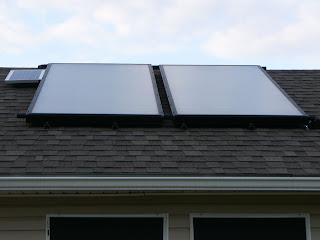
The south face of my house has 3 large windows and no trees for shading which is great for solar panels and heat gain in the winter, but not so great in the summer. My first thought to reduce the solar gain in the summers was to put up awnings. Awnings are a great permanent way to block the sun when its high in the summer and let it in when its lower in the winter. The only problem I had with awnings was the permanent part. I've been considering a screened porch on the south side of the house but I haven't arrived at a location. So I next considered the solar films that you can put in the windows to block the UV radiation and excess heat. But I wanted something I could re-use for a few years until I've settled on a screened porch, deciduous trees, or awnings. Deciduous trees are recommended for house shading because they lose their leaves in the winter but provide shade in the summers. Needless to say as the title suggests I picked solar screens to help block UV radiation and a large amount of heat. I picked up the screen material and frame pieces at Lowe's. The screen material was about $14 and the frame kit was about $12 each. Other than that you need a screening tool to compress the spline into the frame and some screen clips to hold them on the house. After completing the first screen I installed it and measured the temperature of the window sill with the screen versus the sill without the screen and found the screened sill was 10 degrees cooler! We've noticed a big difference this past month in our den which has the most glazing in the house and is typically warmer than any other rooms. As soon as winter arrives they will come down and let some heat back in.







